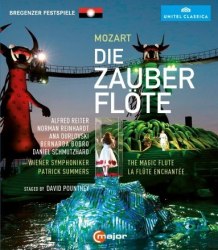|

|
Wolfgang Amadeus MOZART ( 1756-1791)
Die Zauberflöte K620 (1791)
Pamina - Bernarda Bobro (soprano); Tamino - Norman Reinhardt (tenor);
Papageno - Daniel Schmutzhard (baritone); Sarastro - Alfred Reiter
(bass); Queen of the Night - Ana Durlovski (soprano); Papagena - Denise
Beck (soprano); Speaker - Eik Wilm Schlute (bass); Monostatos - Martin
Koch (tenor); Three ladies - Magdalena Anna Hoffmann, Verena Gunz,
Katrin Wundsam
Vienna Symphony Orchestra and Bregenz Festival Chorus/Patrick Summers
Stage Director: David Pountney
Set Designer: Johan Engels
Costume Designer: Marie-Jeanne Lecca
Lighting Director: Frabrice Kebour
Video Director: Felix Breisach
rec. live, Bregenz Festival, Seebühne, July 2013
Filmed in High Definition; 1080p; Format 16:9.
Sound formats: PCM Stereo; DTSHD-HD 5.0
Subtitles: German (original language), English, French, Spanish, Korean, Chinese.
C MAJOR  713804
[150:00] 713804
[150:00]
With the death of the relatively enlightened Emperor Joseph II, who had commissioned Cosi fan tutte
and may even have suggested its plot to Mozart, the composer’s source
of operatic patronage appeared to have dried up. Given his parlous
financial state he welcomed Emanuel Schikaneder’s suggestion that he
compose a magic opera for his Theater auf der Wieden. The two had
resumed friendship when Schikaneder returned to Vienna in 1789 and they
shared fellowship of the same Masonic Lodge. The Theater auf der Wieden
was a popular theatre holding around one thousand and had a reputation
for mounting productions featuring elaborate machinery, live animals,
spectacular lighting and scenic effects. These were interspersed with
topical jokes in the local patois and songs to suit an unsophisticated
audience.
Various sources have been
suggested for Schikaneder’s libretto with much discussion of the
relationship of the trials undergone by Tamino and Pamina, and the
triumph of good over evil and of the Masonic background of the composer
and the librettist. The Masonic influence is also claimed by reference
to the frequent occasions on which the number three occurs. It is said
that this number is significant in Freemasonry. Certainly the number
occurs with the Three Ladies, and Boys as well as in the musical
structure. On the other hand Masonic allegory seems not to be borne out
by the fact that there are only two trials: of fire and water. If there
were Masonic allusions surely they would be to the three steps and
trials an initiate has to undergo.
Die Zauberflöte
was very much in the tradition of the Theater auf der Wieden: a popular
entertainment with as much spectacle as possible. In the operatic world
of today, magnificent Roman amphitheatres not excepted, there is no
other venue for spectacle that matches that offered by Bregenz. The
booklet gives details regarding what was involved in the creation of
what was intended as a spectacular. Facts given include that it took
215 days for construction of the stage with 119 piles being driven down
6 metres into the lake bottom. The three dragons overlooking the
multi-tiered stage weighed over 60 metric tons. With audiences of seven
thousand providing the necessary income, further visual miracles should
have been the order of the day. In a way they were, but these are often
overdone or executed in a meaningless manner that in no way illuminates
any of the inner meanings of an opera widely accepted as having
diversity of interpretation as well as being the most popular in the
art form. Seeing the whole tiered stage and action, dominated by three
very large dragons, would be, I guess, rather different to seeing mid
views, let alone close-ups of singers. Only rarely does the video
director get to show us the wider visual perspective that would be seen
by the paying audience. To a degree this is understandable in the
pervading darkness. However, the film falls between two stools, that of
conveying Mozart’s pantomime and of showing the staging spectacle with
its many costume variations, some rather gimmicky such as the three
ladies costumed as prehistoric birds. The blades of inflated grass on
one side of the rotating stage, variously coloured by imaginative
lighting, were among the more visually effective images.
The costumes varied between rather plain for the three leading
protagonists, with Papageno not looking cute in white and orange, to
bizarre and largely incomprehensible for Sarastro and other members of
his entourage. That for the Queen of the Night was better without being
spectacular. The trial of fire was also impressive whilst that of water
seemed an opportunity missed. The singing, all being mouth-miked, was
very variable and largely undistinguished. That of the Sarastro was
inadequate compared with the competition. Likewise the conducting of
Patrick Summers showed neither serious nor comic vision.
In a year that has seen at least three other video issues of staged
performances of this opera, a musically abbreviated Die Zauberflöte,the reduction consequent on playing without interval, is hardly likely to cut the mustard for serious opera enthusiasts.
My preference still lies with the 1982 Salzburg production.
Robert J Farr
 |
 |
|
